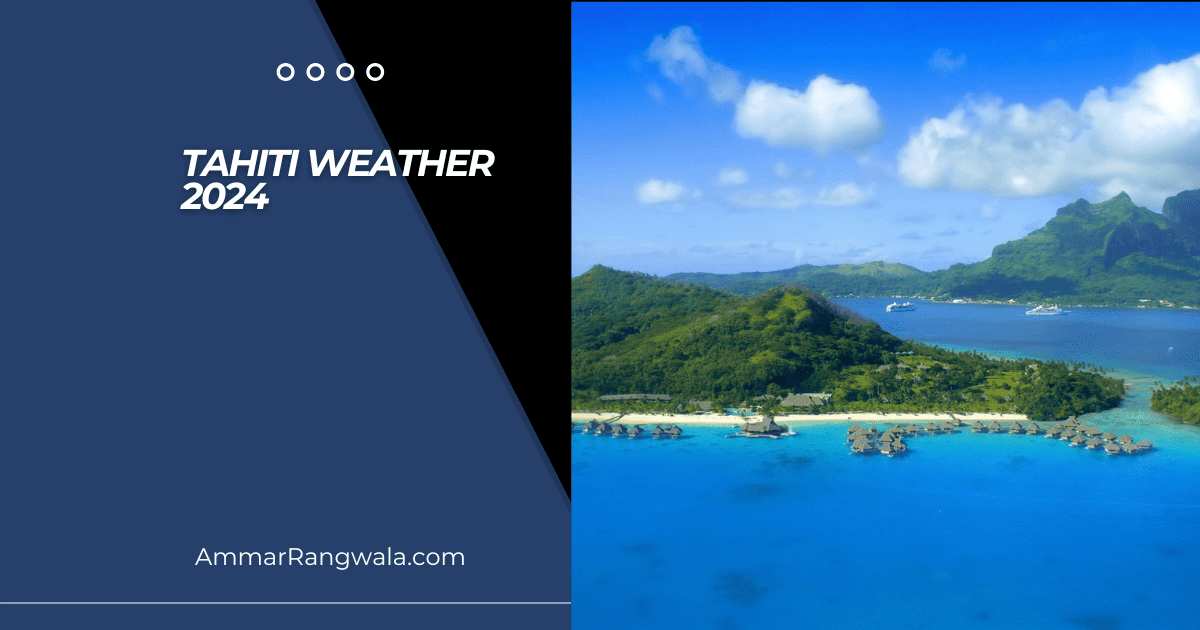Tahiti Weather Guide 2024

Towering volcanic peaks draped in emerald rainforests, turquoise lagoons teeming with colorful fish and coral reefs bursting with life – Tahiti’s breathtaking landscapes paint a tapestry of raw beauty. Yet, beyond the postcard perfection lies a vibrant culture steeped in ancient traditions, where the island’s pulse beats strong. But before you pack your bags for this Polynesian paradise, you must understand Tahiti weather.
From the sun-drenched days of the dry season to the occasional rain showers that paint the island green, each weather pattern unveils a different facet of this captivating destination. This is where this guide comes in. As you compass through the island’s climatic moods, we’ll demystify Tahiti’s weather, helping you plan the perfect trip that aligns with your desired experiences.
Whether you crave the warmth of uninterrupted sunshine or relish the refreshing touch of a passing rain, understanding Tahiti’s weather patterns will unlock the full potential of your adventure. So, let’s ensure your Tahitian experience is as unforgettable as the island.
Unveiling Tahiti’s Climate
Tahiti, nestled in the South Pacific, boasts a subtropical climate that welcomes warmth and sunshine year-round. Unlike many regions, dramatic seasonal shifts are mainly absent, offering a consistent tropical haven for visitors.
Wet Season (November to April): This period increases rainfall, with November averaging the highest precipitation. Though showers tend to be brief and refreshing, bringing life to the lush landscapes, average high temperatures range from 82°F to 86°F (28°C to 30°C), ensuring pleasantly warm conditions. Humidity rises slightly, but trade winds generally maintain a comfortable atmosphere.
Dry Season (May to October): Rainfall becomes less frequent, offering clearer skies and sunshine. High temperatures remain comfortably warm, averaging between 79°F and 82°F (26°C to 28°C). This period is renowned for its tranquil charm and minimal humidity, making it ideal for outdoor activities and exploring the island’s beauty.
One constant element shaping Tahiti’s climate is the trade winds. These gentle breezes blow consistently from the east, tempering the tropical heat and contributing to the island’s pleasant weather. They also shape regional variations, with the west coast generally receiving less rainfall due to the mountainous interior’s sheltering effect.
Navigating the Seasons
Whether you crave sunshine and vibrant crowds or prefer a quieter immersion in nature’s beauty, choosing the right season for your trip can drastically impact your experience. Let’s explore the distinct charms of both dry and wet seasons:
Dry Season Delights
Sunny skies dominate the dry season, painting the landscape warmly and offering ample opportunities to soak up the rays. Beaches transform into playgrounds, inviting swimming, snorkeling, and soaking up the refreshing warmth.
With minimal rainfall, the dry season is perfect for exploring the island’s natural wonders. Hike through verdant trails and scenic bike rides, or challenge yourself with adventurous activities like rock climbing or kayaking.
The dry season often coincides with peak tourist season, bringing festivals and cultural celebrations to life. Take part in traditional music, dance, and local customs, gaining a deeper understanding of the island’s heritage.
Wet Season Wonders
While it’s true that brief showers punctuate the wet season, they quickly give way to clear skies, leaving behind lush landscapes bursting with verdant beauty. Waterfalls cascade with renewed vigor, offering breathtaking sights and refreshing dips.
With fewer crowds and potentially lower travel costs, the wet season presents an ideal opportunity for peace. Enjoy secluded beaches and hidden coves, and connect with nature at your own pace.
This season brings forth an abundance of fresh produce and vibrant flora. Sample seasonal delicacies at local markets, participate in harvest festivals and witness the island’s natural rhythm come alive.
Microclimates and Regional Variations
Tahiti’s diverse topography and island chain layout create a fascinating mosaic of weather patterns. While the overall climate remains tropical, remember that local variations can be significant. Even within individual islands like Moorea, the drier west coast basks in more sunshine than the lush, rainfall-prone eastern slopes. Similarly, Bora Bora’s central mountains harbor rainforests experiencing heavier precipitation than coastal areas.
To accurately plan your trip, drilling down beyond general forecasts is crucial. Seek out localized weather reports specific to your chosen destination within Tahiti. Consider consulting with travel experts or locals familiar with the area’s microclimates. By understanding the nuances of weather patterns, you can tailor your packing, activities, and expectations for a truly memorable Tahitian experience.
Planning Your Tahitian Escape
Let’s unpack the essentials for a fulfilling experience, regardless of the season:
Conquering the Dry Season (December-May):
- Sunscreen is king. Pack broad-brimmed hats, UPF-rated clothing, and reef-safe sunscreens with solid UV protection.
- Hydration is key. Pack refillable water bottles and consider electrolytes for extra support under the tropical sun.
- Light and airy layers are ideal. Pack quick-drying fabrics like cotton or nylon to adapt to warm days and cool evenings.
- Rain showers can pop up. Include a lightweight, packable raincoat in your bag.
- Remember to underestimate humidity. Opt for natural fibers like cotton or linen that breathe better in warmer temperatures.
Embracing the Wet Season (June-November):
- Pack for changeable weather. Bring layers like a light rain jacket and quick-drying pants.
- Waterproof shoes are crucial. Sudden downpours call for comfortable walking shoes with good traction.
- Wear moisture-wicking socks. Wool or synthetic socks keep your feet dry even when caught in scattered thunderstorms.
- Remember your swim gear. Even with rain, the sunshine makes frequent appearances, perfect for enjoying the stunning beaches.
- An umbrella is helpful. Opt for a lightweight, wind-resistant one for unexpected showers.
Activities Tailored to the Weather Gods’ Whimsy
- Dry Season Splendor (December-May): Bask in the sunshine with swimming, hiking, exploring ancient marae (temples), or indulging in stand-up paddleboarding.
- Wet Season Wonder (June-November): Visit local villages, learn traditional crafts, relax with a book, and enjoy the scenic landscapes.
Sun Protection and Hydration: Year-Long Commitments
Remember, Tahiti boasts tropical sunshine year-round. Sun protection is crucial no matter the season. Hydration is equally important to combat warm temperatures and humidity. Pack sufficient water bottles and consider carrying water purification tablets for remote adventures.
Additional Considerations
While the weather forecast offers a valuable snapshot, there’s more to consider when planning your Tahitian adventure. Let’s explore some additional factors to ensure a smooth and enriching experience:
Tahiti’s wet season (November to April) carries a whisper of potential cyclones. While these events are uncommon, staying informed is crucial. Monitor weather updates from reputable sources like Meteo France or the Joint Typhoon Warning Center (JTWC). If a cyclone is anticipated, prioritize safety by following official instructions and adjusting your travel plans if necessary. Remember, preparation is critical to turning potential concerns into mere footnotes in your Tahitian story.
Cyclical climate patterns can influence Tahiti’s weather. El Niño typically brings warmer and drier temperatures, while La Niña tends towards cooler temperatures and increased rainfall. While predicting their exact impact can be tricky, staying informed through sources like the National Oceanic and Atmospheric Administration (NOAA) can help you adapt your expectations and pack accordingly.
Remember, Tahiti’s weather is a part of its character. Sudden downpours can transform into dazzling rainbows, and passing clouds can unveil breathtaking sunsets. Instead of viewing these shifts as inconveniences, see them as opportunities to witness the island’s dynamic beauty. Pack quick-drying layers, consider waterproof accessories, and be open to adjusting your itinerary based on the day’s rhythm.
Understanding these additional considerations enables you to approach your Tahitian adventure with informed preparedness and open-mindedness. Remember, Tahiti’s weather is as unique as its culture, and understanding its natural rhythm will enrich your experience, creating memories that transcend the forecast.
Summary
Tahiti’s weather, with its distinct dry and wet seasons, offers unique experiences for travelers. Warm sunshine and calm seas dominate the dry season, ideal for swimming, snorkeling, and basking on pristine beaches. If you crave adventure, the shoulder months offer a balance of sunshine and occasional rain showers, perfect for exploring lush rainforests and waterfalls. While the wet season brings increased rainfall, it paints the island in vibrant greenery and offers a glimpse into its wilder side. Remember, showers are usually brief, refreshing bursts, not extended downpours.
So, pack your bags and book your Tahitian adventure with confidence. Remember, flexibility is vital. With some planning and an open mind, you can experience what Tahiti offers, rain or shine.
Ammar has started several online businesses and is a blogger who loves providing quality content to help others. He is involved with affiliate marketing, domain names, NFTs, and cryptocurrencies. Check out my blog if you want to learn more about these areas and business in general.






